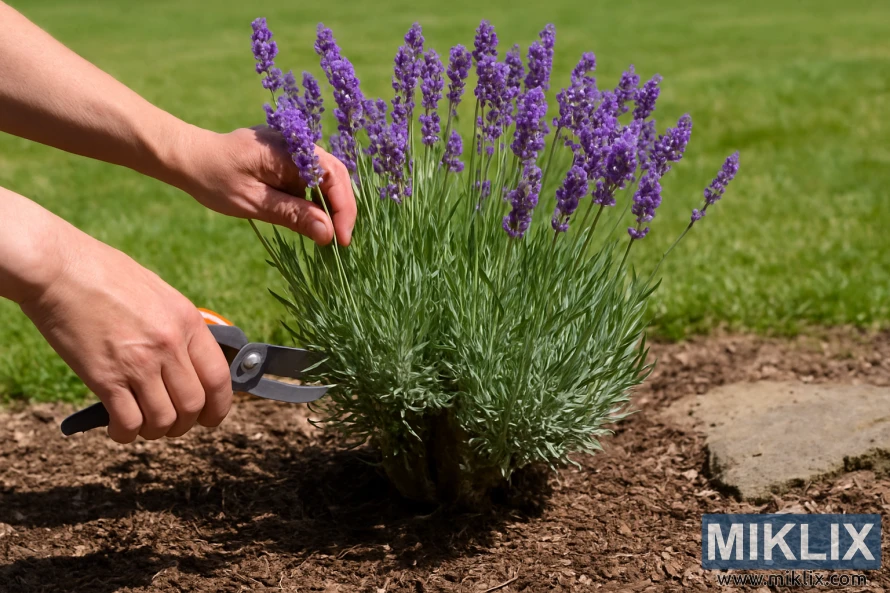Image: Proper Lavender Pruning Technique Demonstrated
Published: October 22, 2025 at 9:53:40 PM UTC
Learn how to prune lavender correctly. This close-up photo shows the proper technique — cutting just above the woody base to encourage healthy, compact growth and future blooms.
This detailed close-up photograph captures the proper pruning of a mature lavender plant (Lavandula spp.) in a well-maintained summer garden. The scene shows a pair of careful, gloved hands using sharp garden shears to trim back the soft green growth of the plant just above its woody base — a technique that is essential for maintaining lavender’s shape, health, and long-term vigor. Bathed in warm, natural sunlight, the image beautifully illustrates both the practical steps and horticultural principles behind effective lavender pruning.
At the center of the image is a healthy lavender shrub, its silvery-green foliage forming a dense mound and its upright flower stems tipped with vibrant purple blossoms. The plant is at the ideal stage for pruning: the main flowering period has passed, and many of the blooms are fading, signaling that it’s time to cut back the spent stems to encourage fresh growth and prepare the plant for the next flowering cycle. The focus is on the lower part of the plant, where the gardener is carefully positioning the shears — demonstrating the golden rule of lavender pruning: cut into the soft green growth but never into the woody, brown base.
The composition highlights this principle visually. The shears are angled just above the woody stems, positioned precisely where the green foliage transitions from soft and pliable to more rigid and mature. This detail is crucial, as cutting into the woody part of the plant can cause irreversible damage and inhibit future growth, while trimming too lightly above the new growth can result in a leggy, unbalanced shape. By cutting back by roughly one-third to one-half of the current season’s growth, as shown here, the gardener is encouraging the development of a compact, rounded form and stimulating vigorous new shoots for the next season.
The texture and coloration of the lavender are beautifully rendered. The foliage is a silvery gray-green, soft and slightly fuzzy to the touch, while the remaining flower stems are a striking purple — a vivid reminder of the plant’s recent blooming phase. The contrast between the cool tones of the lavender and the rich brown of the mulched soil beneath adds depth and visual appeal to the composition. In the background, a soft blur of green lawn and distant garden plants creates a natural, peaceful setting that keeps the viewer’s attention focused on the pruning action in the foreground.
The hands of the gardener — steady, deliberate, and positioned with precision — add a human element that emphasizes the care and skill involved in lavender maintenance. The open blades of the shears, poised mid-cut, suggest movement and purpose, capturing the process at the perfect instructional moment. The sunlight filtering over the scene highlights the plant’s delicate textures and brings out the natural sheen of the shears’ metal, while casting gentle shadows that enhance the three-dimensional detail of the image.
This photograph is more than just a garden scene — it’s a practical visual guide to one of the most important aspects of lavender care. Proper pruning like this extends the lifespan of the plant, promotes dense growth and abundant flowering, and helps maintain its iconic rounded shape. It also improves airflow and reduces the risk of fungal disease, ensuring a healthier, more resilient lavender plant. Whether used for educational purposes, gardening instruction, or landscape design inspiration, this image perfectly illustrates the art and science of lavender pruning in a natural, real-world context.
The image is related to: A Guide to the Most Beautiful Lavender Varieties to Grow in Your Garden

